Radiation Budget of Planet Earth
The balance of radiative inputs and outputs


Learning Objectives
- Because radiation is the only transfer mechanism between our planet and the Sun / Space we can calculate the theoretical radiation budget of Planet Earth.
- Know how to estimate the expected ‘temperature’ of our planet based on our calculation.
- Understand how the presence of the atmosphere affects the temperature on our planet.
Review ‘Short-wave’ vs. ‘Long-wave’
Short-wave: \(\lambda <=3 \mu m\)
- At 5800 K: \(\lambda\) max is 0.50 \(\mu m\)
Long-wave: \(\lambda >3 \mu m\)
- At 288 K: \(\lambda\) max is 10.35 \(\mu m\)
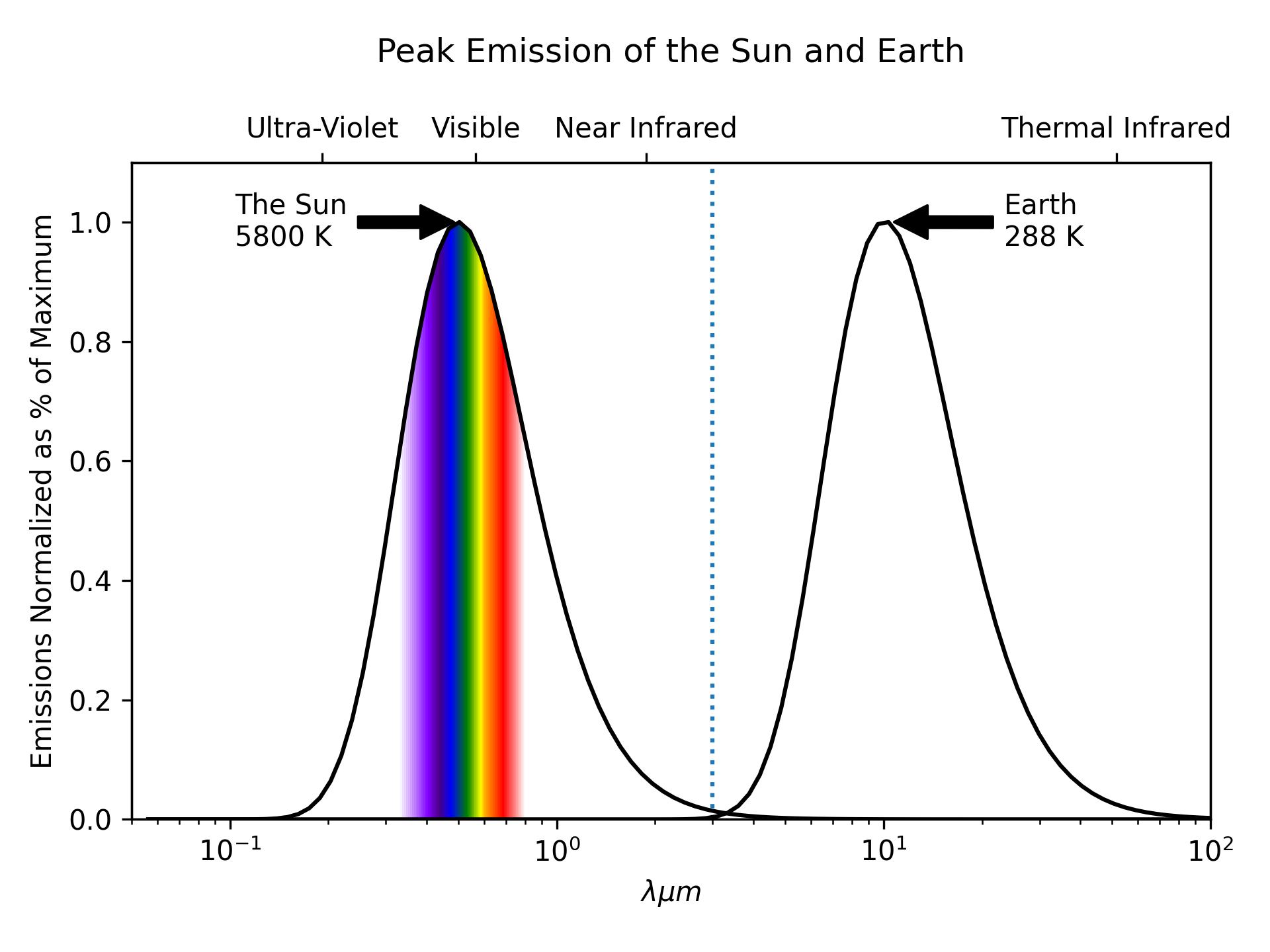
What is the solar constant \(I_0\)? (iClicker)
- A The average flux density leaving Sun’s surface
- B The average flux density reaching the Earth’s surface
- C The average flux density reaching the Earth’s orbit perpendicular to the beam
- D The average flux density reaching the Earth’s orbit averaged over the sphere of the planet
Partitioning the Solar Constant
\(I_0 \approx\) 1361 W m-2.
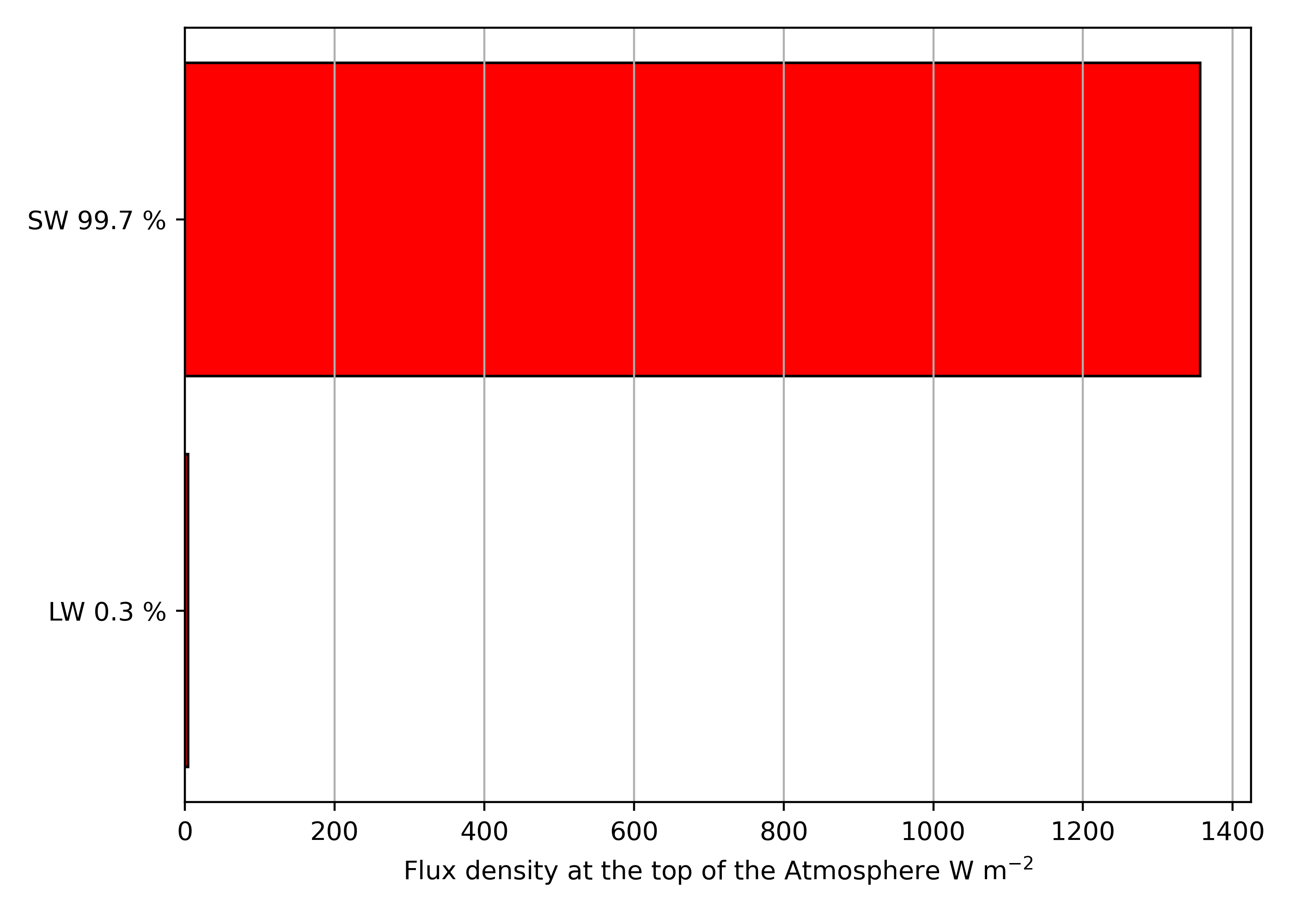
Equilibrium
Earth absorbs incoming \(SW\) from the Sun
Earth emits \(LW\) to Space
- These two fluxes can be considered in equilibrium. Why?
- \(F_{in}\) = Short-wave
- \(F_{out}\) = Long-wave

Planetary Albedo
Not all \(SW\) that reaches a planet from sun is absorbed, a fraction is reflected back to Space.
- Planetary albedo \(\alpha\): the % of \(SW\) reflected back to Space
- \(\alpha\) is mainly controlled by:
- Cloud type/cove
- Extent of ice and snow
- Earth’s \(\alpha\) = 31%
- \(\alpha\) is mainly controlled by:

Planetary Absorption
Transmission through Earth is impossible; \(a = 1 - \alpha\)
- Earth’s Albedo: \(\alpha \approx 31\%\)
- Atmosphere: 22%
- Clouds, droplets, aerosols
- Surface: 9%
- Atmosphere: 22%
- \(a = 100\% - 31\% = 69\%\)
- Atmosphere: 20%
- Surface: 49%

Planetary Absorption
Recall the solar constant \(I_0\): the radiant flux density at the top of the atmosphere perpendicular to the solar beam.
- \(SW\) Flux into the Earth (\(F_{in}\)) in W is:
\[ F_{in} = A^*(1-\alpha)I_0 \qquad(1)\]
- \(I_0\) (W m-2) projected over Earth’s silhouette area (\(A^* = \pi r^{2}\)) in m2
- Adjusted for \(\alpha\)
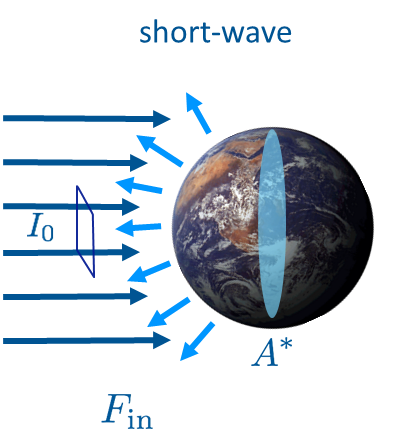
Planetary Emission
Planetary \(LW\) emission (\(F_{out}\)) in W can be approximated as a function of temperature using Stefan-Boltzmann.
\[ F_{out} = AI_{out} = 4\pi R^{2}\epsilon\sigma_b T^4 \qquad(2)\]
- Average flux density (\(I_{out}\)) in W m-2 times Earth’s surface area
- \(\epsilon_{surface} \approx 0.95\)
- \(T \approx 288 K\)
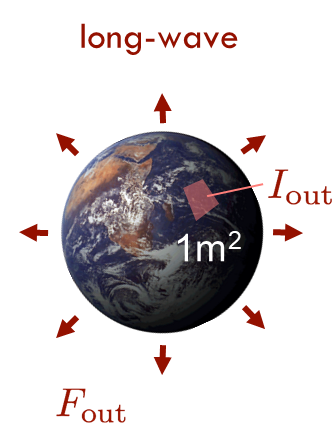
Surface Emissivity
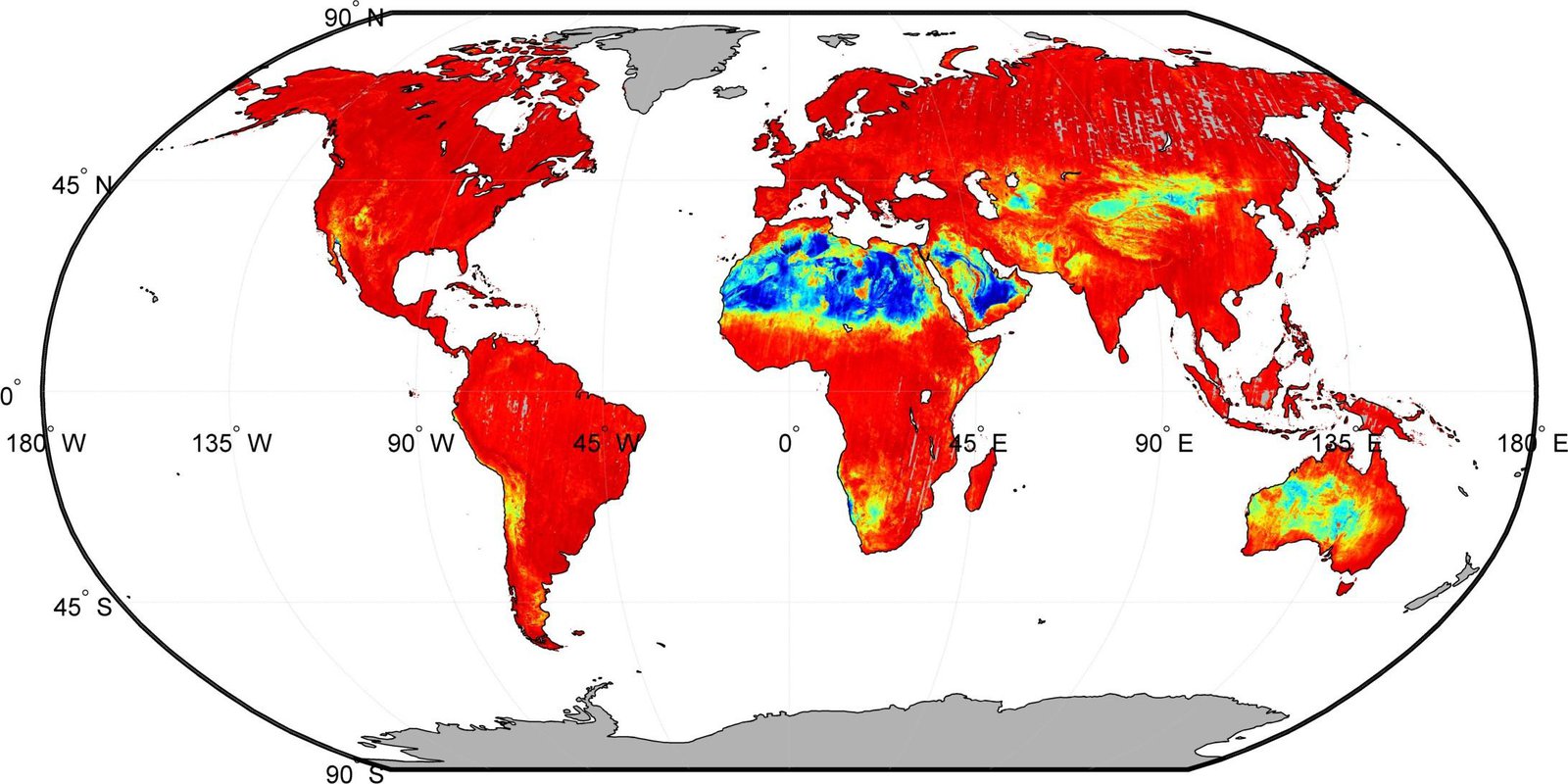

Simplified Energy Balance:
Let us assume an equilibrium state, i.e. \(F_{in} = F_{out}\)
\[ \pi R^{2} (1-\alpha)I_0 = 4\pi R^{2}\epsilon\sigma_b T^4 \qquad(3)\]
- Outgoing \(LW\) will balance out incoming \(SW\)

Geometric Considerations
Earth receives \(SW\) only from ‘one side’; but emits \(LW\) in all directions to space.
\(F_{in}\) is distributed over the silhouette area \(A^*\) of Earth
\(F_{out}\) is from the whole surface area \(A\) of Earth
- Note \(F_{out}\) is not constant across space
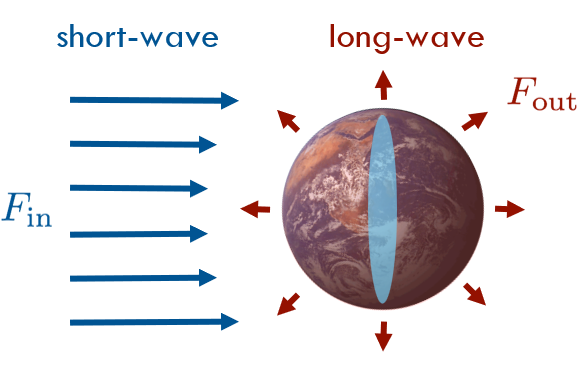
Earth’s Surface Temperature (iClicker)
The area terms (\(\pi R^2\)) in Equation 3 cancel on both sides; leaving us with
\((1-\alpha)I_0 = 4\epsilon\sigma_b T^4\)
Rearranging to solve for T:
\(T = \sqrt[4]{\frac{(1-\alpha)I_0}{4\epsilon\sigma_b}}\)
\(T \approx\) 256.9 K
Is this value realistic?
A - Yes
B - No (underestimate)
C - No (overestimate)
Effect of an atmosphere
Earth’s known average surface temperature is 15 ° C.
The previous calculation underestimates surface temperature because we have not incorporated the atmosphere i.e. the effects of greenhouse gases.
Without an atmosphere it would be \(T \approx\) -16.2 ° C on Earth on average.
- The effect of the atmosphere (natural greenhouse effect) must be worth \(\approx\) 31.2 K!
The ‘Greenhouse Effect’
The atmosphere has an insulating effect on planet earth.
- The greenhouse gas effect limits the \(\tau_{LW}\) through the atmosphere
- This effectively reduces Earth’s \(\epsilon_{LW}\)
- But how? Kirchhoff’s law states that \(\epsilon_{\lambda} = a_{\lambda}\)?
- The \(a_{LW}\) is re-emitted in all directions
- i.e., it is recycled
- Loss of energy from the surface slowed
The ‘Greenhouse Effect’
The atmosphere is a selective absorber (and emitter) of radiation.
- The transmission window allows some \(LW\) through
- Outside of that window, little \(LW\) escapes!
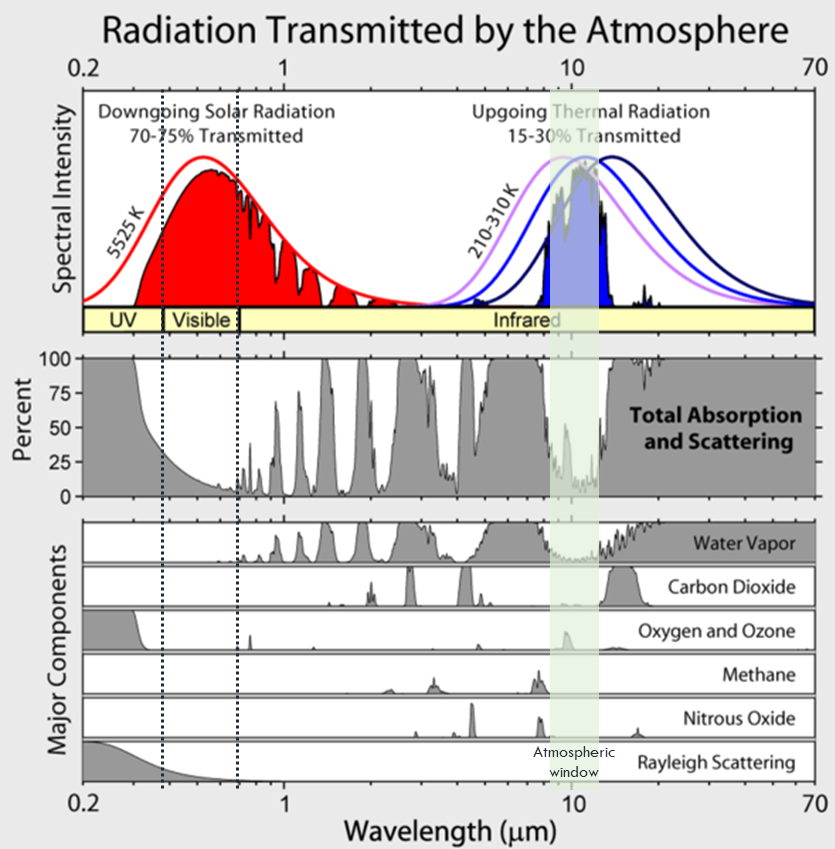
The Effective Emissivity
Since we know the mean surface temperature of the earth, we can instead rearrange Equation 3 to solve for \(\epsilon\):
\(\epsilon= \frac{(1-\alpha)I_0}{4\sigma_bT^4}\)
The atmosphere reduces the global value of \(\epsilon\) to \(\approx\) 0.601
Radiative Output
Since we now have a reasonable estimate of \(\epsilon\), we estimate planetary emissions following Equation 2.
\(F_{out} = AI_{out} = 4\pi R^{2}\epsilon\sigma_b T^4\)
The average flux density of \(LW\) at the top of Earth’s atmosphere \(I_{out} \approx\) 234.8 W m-2
The average flux of \(LW\) from Earth \(F_{out} \approx\) 1.2001616^{17} W
Radiative Output (iClicker)
Our estimated value of \(I_{out}\) (234.8 W m-2) \(\neq I_0\) (1361 W m-2).
What accounts for the discrepancy?
A - \(I_0\) is distributed across Earth’s silhouette area \(A^*\); we need distribute \(I_0\) across Earth’s total surface area \(A\)
B - A portion of \(I_0\) is never absorbed by the Earth due to the planetary Albedo (\(\alpha \approx 0.31\))
C - Both A & B
Radiative Output
If we account for both, we’ll get the average flux density at the top of Earth’s Atmosphere across the Full electromagnetic spectrum.
\(\bar{I_0} = \frac{I_0}{4}\) = 340.25 W m-2
\(\bar{I_0}= \bar{I_0} \alpha + I_{out}\) = 105.4775 W m-2 + 234.7725 W m-2
Important greenhouse gases
| Compound | Abundance pre industrial | Abundance 2011 | Lifetime yr | Effect of human enhancement |
|---|---|---|---|---|
| H2O | Variable | Variable | 0.03 | — |
| CO2 | ~280 ppm | 393 ppm | 5 - 200 | 1.85 W m-2 |
| CH4 | ~700 | 1874 ppb | 12 | 0.51 W m-2 |
| N2O | ~270 | 324 ppb | 114 | 0.18 W m-2 |
| Ozone O3 | 25 ppm | 34 ppm | days | 0.35 W m-2 |
| Misc. Trace Gasses | 0.34 W m-2 * | |||
| All | 3.23 W m-2 |
Test your knowledge (iClicker)
What is the most important greenhouse gas contributing to the natural greenhouse effect on our planet?
- A Ozone
- B Carbon dioxide
- C Methane
- D Oxygen
- E Water vapour
Test your knowledge
What is the most important greenhouse gas contributing to the natural greenhouse effect on our planet?
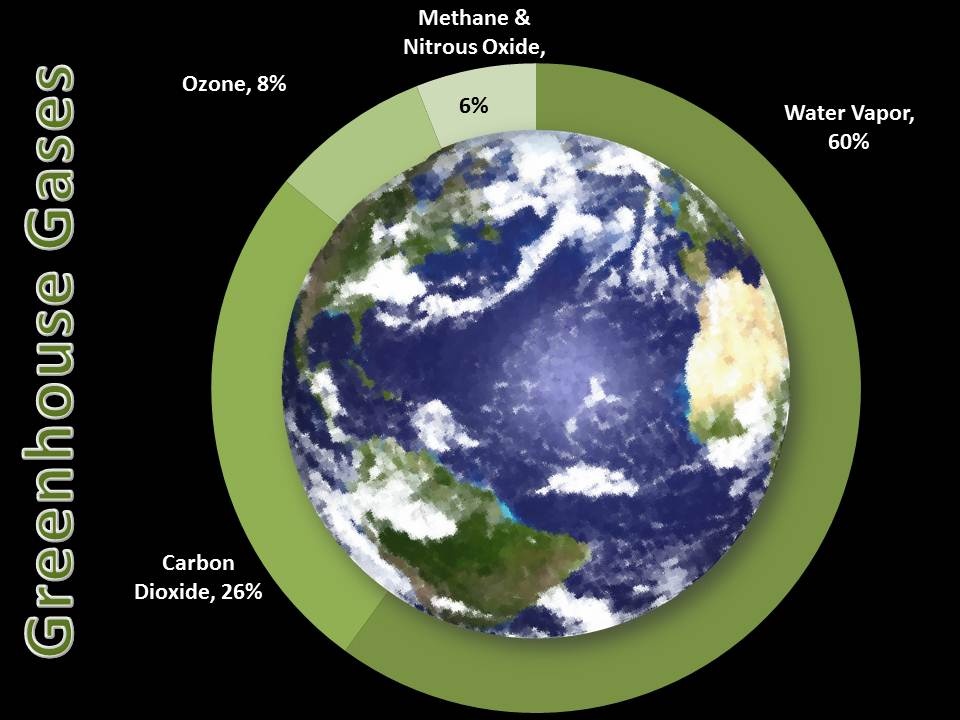
A more Realistic Energy Balance
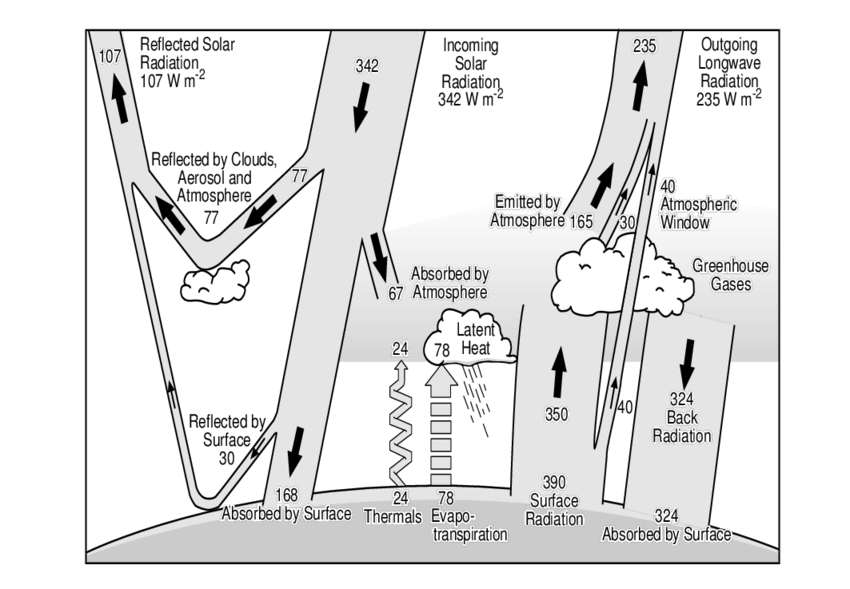
Magnitudes from Kiehl and Trenberth (1997, Bull. Am. Met. Soc.) in IPCC 2001.
There is no net gain or loss for Earth
\(SW\) input (100%) = \(SW\) loss (31%) + \(LW\) (69%):
- \(I_{0} = \bar{I_0} \alpha + I_{out}\)

Energy Balance of the Atmosphere
- The Atmosphere appears to be in radiative deficit
- Should be cooling
- The surface in radiative surplus
- Should be warming
- Why is this not happening?

Energy Balance of the Atmosphere
- Earth’s surplus is convected by sensible and latent heat flux into the Atmosphere
- Offsets the radiative imbalance,
- i.e. the whole energy balance is involved not just radiation

Latent Heat Flux (iClicker)
How is a latent heat flux into the Atmosphere realized?
- A - Water is vaporized by radiation at the surface and condenses in clouds - there it warms up air.
- B - Radiation absorption at surface warms up air near surface - warm air rises and transports extra heat to higher layers of atmosphere.
- C - Rain releases its geopotential energy as raindrops splash at the surface - they warm up the surface more than the atmosphere.
Take home points
- The planet is using (absorbing) only 69% of the solar radiation received. The planetary albedo is 31%.
- Without atmosphere it would be -16.5579764$° C on Earth on average. The natural greenhouse effect is worth -31.2 K.
- The atmosphere is in a radiative deficit and the Planet’s surface shows a radiative surplus. Sensible and latent heat fluxes offset the radiative imbalance, i.e. transport energy from the surface into the atmosphere.